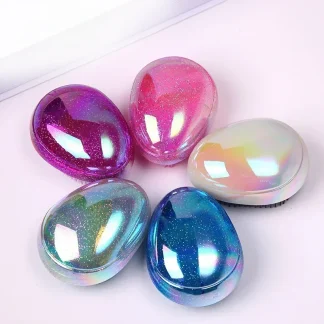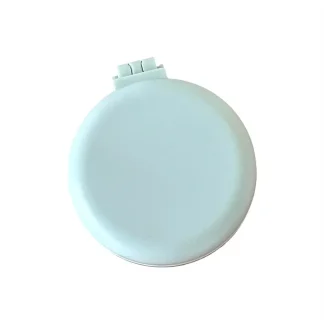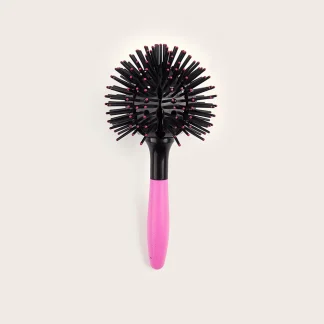Cylindrical Hair Stylers: The Sculptor’s Tool in the Art of Hairstyling
The round hair brush is far more than a humble styling instrument. It is the hairstylist’s sculptor’s chisel, a tool capable of transforming shape, volume, and direction with a single twist. Wielded with dexterity, the cylindrical styler creates movement and architecture—bends, flips, waves, and volume that defy gravity. From classic Hollywood blowouts to voluminous modern manes, the barrel-shaped grooming aid has carved its place into beauty history. Today, it remains an icon of technique, precision, and controlled glamour.
Ancient Precedents: Where Volume Began with Early Shaping Implements
Though the barrel-shaped styler as we know it is a 20th-century innovation, the desire to create curves and volume in tresses is ancient. In early Roman and Greek societies, coiffures were styled into elaborate coils, waves, and buns—often aided by rudimentary implements that mimicked cylindrical forms. Bronze and bone rods were used to curl strands, and in many cultures, heated rods wrapped with locks of hair created temporary curls or fullness—an early nod to the modern circular brush’s shape-shifting capabilities.
During the Renaissance, both men and women employed cylindrical tools to style manes into rounded shapes or ringlets. The idea of using circularity as a beauty element became deeply ingrained in Western ideals of attractiveness. By the 19th century, this aesthetic was reflected in curling tongs and styler-comb hybrids used to roll and shape tresses for grand hairstyles of the Victorian elite.
The Rise of the Volumizing Styler in Modern Hairdressing
The contemporary round hair brush was born out of necessity in the golden age of blow-drying. With the invention of the handheld hair dryer in the early 20th century, hairdressers needed implements that could help style locks while they dried—tools that not only detangled but also shaped, lifted, and curled. The cylindrical grooming aid answered that call with elegance and engineering.
By the 1950s and 60s, as fashion emphasized volume and control—think bouffants, flips, and backcombed elegance—barrel-shaped stylers became indispensable in salons. These brushes had cylindrical barrels wrapped with bristles that allowed stylists to roll, curl, or straighten coiffures while guiding the airflow of a dryer. The technique was revolutionary and soon spilled into homes, becoming a regular part of beauty routines.
The Blowout Era: Cylindrical Brushes and Iconic Hairstyles
This type of shaping tool reached the height of its cultural relevance in the era of the professional blowout. The 1970s gave us feathered layers and disco waves. The 1980s added mega-volume and bold flips. But it was the 1990s and early 2000s that cemented the round hair brush’s celebrity status. Blowouts became a ritual—high-maintenance yet irresistibly stylish.
Volumizing stylers created the lift at the roots, the bounce in the mid-lengths, and the curve at the ends. Women around the world chased the shiny, full looks made popular by supermodels, news anchors, and pop icons. The circular grooming aid had become a sculptural extension of the hand—capable of fluid motion and commanding shape.
Design and Function: The Anatomy of the Barrel-Shaped Implement
What makes the round brush distinct is its cylindrical barrel, designed to help wrap hair around it for styling. Bristles—natural, synthetic, or a combination—grip the strands while heat from a blow-dryer sets the shape. Barrel sizes vary dramatically, with smaller diameters creating tighter curls and larger barrels offering smooth volume and flips.
Vented circular stylers allow better airflow for faster drying. Thermal implements include metal or ceramic barrels that retain heat like a curling iron, helping set styles more efficiently. The spacing and texture of the bristles also play a crucial role, with denser bristles offering more tension and smoother results, and widely spaced bristles providing gentle detangling.
The Round Hair Brush Across Hair Textures
Though often associated with straight or wavy hair types, cylindrical grooming aids are remarkably adaptable. For curly or coily tresses, they can assist in stretching and smoothing strands prior to protective styling or flat ironing. For fine locks, they create illusionary volume. For thick manes, they help sculpt manageable shapes with lasting hold.
Modern variations include boar-bristle round stylers for shine, ceramic-coated barrels for thermal conductivity, and even combination brushes that integrate ionic technology. These innovations reflect the barrel-shaped tool’s ongoing evolution to meet the changing needs of diverse coiffure types and styles.
Cultural Influence and Fashion Legacy of Volumizing Stylers
The circular has been a silent partner in some of the most influential hair trends of the 20th and 21st centuries. Think Farrah Fawcett’s iconic flip, Jennifer Aniston’s “Rachel” layers, or the polished blowouts of Beyoncé and Kate Middleton. In all these styles, the round hair brush’s role was essential yet invisible—a backstage hero in the theater of hair.
It’s also embedded in salon culture worldwide. The unmistakable sound of a blow-dryer paired with the rhythmic twist of a cylindrical grooming implement defines the experience of professional styling. From Tokyo to Los Angeles, Paris to São Paulo, the barrel-shaped styler signals transformation, preparation, and polish.
The Round Brush as Ritual in Hair Care
Beyond its function, the circular styling tool invites a meditative ritual. There’s a hypnotic cadence to its use—a twist of the wrist, a pull through the strands, a gentle blast of warm air. For many, using a round hair brush is an act of care, control, and elegance. It turns the daily task of mane maintenance into a moment of artistry.
Its characteristic shape also symbolizes completeness, balance, and perfection. Much like the circular motions used in ancient grooming rites, the cylindrical implement continues a tradition of using roundness to convey harmony and beauty. In the quiet intimacy of daily styling, it brings rhythm, intention, and a sense of refinement.
Conclusion: An Essential Tool of Transformation for Tresses
The round hair brush is not merely an accessory—it is an instrument of transformation. With roots in historical grooming and a firm place in the cultural present, it continues to empower people to shape their look and express their identity. Whether you're seeking classic curves, dramatic flips, or sleek, controlled smoothness, the cylindrical styler delivers with grace and precision.
In an era where beauty is increasingly individualized, the barrel-shaped grooming aid remains universal. It adapts, evolves, and endures—always ready to help sculpt style from raw strands. In the hands of a skilled user, it becomes a brushstroke on the canvas of self-expression, a symbol of elegance shaped by motion and intention.

 + 2
+ 2
